Decision-Making: Understanding the Path
For the most part, we all want to make better decisions, make them faster and make them with confidence. But decisions don’t just happen. They are the result of a human process that follows a very predicable path. Understanding this path offers an opportunity for us to enhance the speed and quality of decision-making.
Consider these SIX STEPS in every decision-making process:
1. Acquiring and Accessing INFORMATION (data)
The more data that is available, the better-informed our decisions become.
The more visual the data, the easier it is to assimilate large amounts of different kinds of information.
Data that represents the direct issue at hand (Figure) is more quickly understood in context (Ground).
2. Subjecting the Information to QUESTIONING
Asking visible questions anchors the process in a foundational understanding.
Allowing the answers to those early questions to create new, previously invisible questions increases specificity.
Enlisting computer/machine analytics amplifies speed and efficiencies of the questioning process to further expand the range of questions.
3. INTEGRATING information with experience (Intuition)
Applying lessons learned through experience to the newly acquired fund of information enables speculation, hypothetical solutions and enhanced consideration regarding possible outcomes.
4. Deriving INSIGHTS fuels predictions, speculations, options and opportunities
The process can now generate “what if” scenarios grounded in data.
Creativity in problem solving is greatly enhanced.
5. Applying JUDGMENT in an effort to temper possible choices with important influencers
Decisions are not automatic and purely objective. They require intervening variables like Mission, Values, Priorities, politics, relationships, etc.
6. Finalizing a DECISION, typically either Strategic or Tactical in nature.
Strategic decisions direct goals, direction and priorities
Tactical Decisions direct the means and methods necessary to achieve an outcome.
When the Pathway to Decisions are traveled deliberately, comprehensively and objectively, better decisions can be made faster and with confidence. As a result, Strategy and Tactics become exceptionally powerful and productive.
About the author:
Dr. Ben Fierman serves as the Vice President of Datastory. He has worked extensively in both private, non-profit and public sectors of business. A 25-year veteran of the healthcare industry, he has served as a practitioner and senior executive with responsibility for strategic planning, business development, facility development, operations, marketing, advertising and public relations.
He has developed and implemented system-wide service excellence programs as well as creating Leadership Institutes for Management Development in a variety of organizations. He has taught on the faculty at John Carroll University, Case Western Reserve University College of Medicine and has guest lectured at Malone College, Walsh University and Northeast Ohio Universities College of Medicine.

